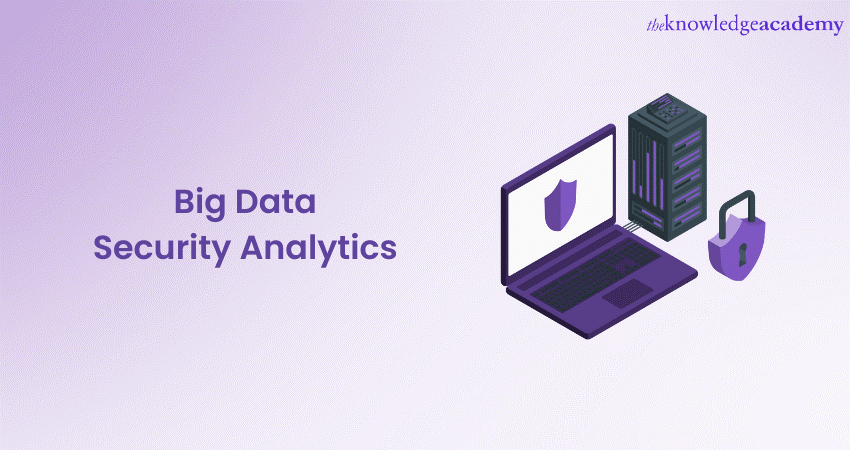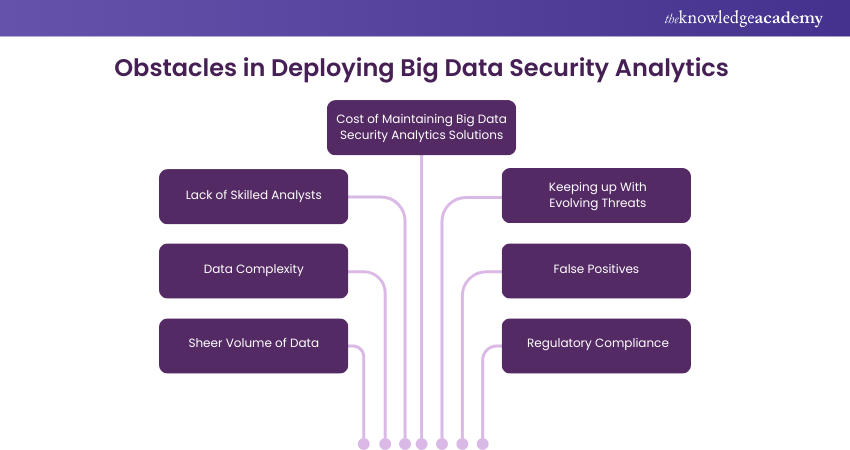We may not have the course you’re looking for. If you enquire or give us a call on 800969236 and speak to our training experts, we may still be able to help with your training requirements.
Training Outcomes Within Your Budget!
We ensure quality, budget-alignment, and timely delivery by our expert instructors.

At a time when data breaches and cyber threats are increasingly common, do you seek ways to secure this data? This is when the Big Data Security Analytics come into play. This powerful tool is essential for protecting sensitive information from cyber threats and breaches. Or how they manage to sift through vast amounts of data to identify potential threats? This detailed blog will talk about its intricacies, offering insights into its applications, benefits, and the tools that make it all possible.
By harnessing the power of Big Data Security Analytics, including cutting-edge techniques like machine learning (ML) and statistical analysis, organisations can achieve unprecedented levels of data protection and threat detection. Curious about how these technologies can transform your approach to data security? Let’s dive in!
Table of Contents
1) Understanding Big Data Security Analytics
2) Big Data Security Tools for Analysis
3) Stages of Big Data Security Analytics
4) The Benefits of Big Data Security Analytics
4) The Challenges of Implementing Big Data Security Analytics
5) Conclusion
Understanding Big Data Security Analytics
Big data encompasses vast and complex datasets that are too large for traditional data processing tools. Often generated through internet user activity, this data is vulnerable to threats and breaches, making Big Data security essential. Big Data Security Analytics involves collecting, storing, processing, analysing, and visualising large volumes of sensitive data to identify and investigate threats. It helps detect and respond to incidents such as data breaches, malware attacks, and insider threats. Sensitive data from sources like network traffic logs, system logs, and application logs can track user activity, identify suspicious patterns, and detect anomalies.
Big Data Security solutions utilise statistical techniques and Machine Learning (ML) to identify potential threats and analyse this data. By leveraging these advanced analytical tools, organisations can enhance their security posture and ensure the integrity and confidentiality of their data.
Big Data Security Tools for Analysis
Big Data Security is crucial when vast amounts of sensitive information are processed and stored. Here are some of the key tools used for Big Data Security Analysis:
1) LogRhythm: LogRhythm is a comprehensive security information and event management (SIEM) platform that provides Machine Learning, advanced analytics, and automation to detect and respond to threats.
2) IBM QRadar: IBM QRadar is another powerful SIEM tool that integrates with various data sources to provide a unified view of security events.
3) Splunk: Splunk is a versatile platform for searching, monitoring, and analysing machine-generated data.
4) Apache Metron: Apache Metron is an open-source Big Data security platform that provides real-time security analytics.
5) Cloudera Data Platform (CDP): Cloudera Data Platform offers comprehensive data security and governance capabilities.
6) Hortonworks Data Platform (HDP): Hortonworks Data Platform is designed for managing and securing Big Data.
7) Kerberos: Kerberos is a network authentication protocol that provides strong authentication for client-server applications.
8) Safe Shell (SSH): Safe Shell (SSH) is a protocol that secures remote login and other secure network services.
9) Internet Protocol Security (IPsec): IPsec is a suite of protocols created to secure Internet Protocol (IP) communications by encrypting and authenticating each IP packet. 10. Data Discovery and Classification Tools: These tools help organisations identify and classify sensitive data across their environments.
11) Vulnerability Assessment and Risk Analysis Tools: These tools are used to identify and assess vulnerabilities in systems and applications.
12) Automated Compliance Reporting: Automated compliance reporting tools streamline the process of generating reports for regulatory compliance.
Keen to have deeper knowledge of Data analytics, refer to our blog on "data Architecture"
Stages of Big Data Security Analytics
Big Data Security Analytics is a complex process that involves a number of different components. These components include the following:

Data Collection
The first step in Big Data Security Analytics is to collect data from a variety of sources, such as network traffic logs, system logs, and application logs. This data can be collected in real time or in batches.
Data Storage
Once Big Data is collected, it needs to be stored efficiently and securely. Big Data Security solutions typically use a distributed storage system like Hadoop to store large volumes of data.
Data Processing
The next step is to process the data, making it ready for analysis. This includes performing the following:
a) Cleaning the data
b) Removing duplicates
c) Transforming data into a format that can be analysed by Big Data Machine Learning algorithms
Data Analysis
The core of Big Data Security Analytics is the data analysis step. This is where Machine Learning algorithms are used to identify patterns and anomalies in the data. These patterns and anomalies can be used to identify potential threats.
Visualisation and Reporting
The final step is to visualise and report the results of the data analysis. This helps organisations understand the threats they face and take steps to mitigate those threats.
Take the next step in your career with our comprehensive Big Data Architecture Training – join us now!
The benefits of Big Data Security Analytics
Big Data Security Analytics evolved Cybersecurity with its immense volumes of data to enhance threat detection and response. The following are some of its major benefits:
Improved Threat Detection
Big Data Security Analytics can help organisations detect threats more quickly and easily by analysing large volumes of sensitive data. This is because Big Data Security Analytics solutions can identify patterns and systems that would be difficult to detect with traditional security tools. For example, Big Data Security Analytics can be used to identify unusual network traffic patterns that may indicate a malware attack.
Reduced Risk of Data Breaches
By detecting and responding to threats quickly, Big Data Security Analytics can help organisations to reduce the risk of data breaches. This is because data breaches can be costly and damaging to an organisation's reputation. For example, Big Data Security Analytics can be used to identify and block unauthorised access to sensitive data.
Increased Compliance With Security Regulations
By providing insights into security risks, Big Data Security Analytics can help organisations to demonstrate compliance with security regulations. This is important because many organisations are subject to regulations that govern how they must protect their data. For example, Big Data Security can be used to track and report on user access to sensitive data, which can help organisations comply with regulations, especially the General Data Protection Regulation (GDPR).
Unlock the power of data with our comprehensive Big Data and Analytics Training - stay ahead in this digital era!
Improved Decision-making
By providing a comprehensive view of security threats, Big Data Security Analytics can help organisations make better decisions about how to mitigate those threats. This is because Big Data Security Analytics can help organisations prioritise their security efforts and allocate resources more effectively. For example, Big Data Security Analytics can be used to identify the most critical assets that need to be protected and to track the effectiveness of security controls.
The Challenges of Implementing Big Data Security Analytics
Big Data Security Analytics is the process of collecting, storing, processing, analysing, and visualising large volumes of security data to identify and investigate threats. It can be used to detect and respond to a range of security incidents, including data breaches, malware attacks, and insider threats. However, there are a number of challenges associated with implementing Big Data Security Analytics. These challenges include the following:

a) The exponential growth of sensitive data makes timely collection, storage, and processing challenging.
b) Unstructured and noisy data from various sources complicates analysis and correlation.
c) A shortage of skilled analysts hinders the effective implementation of Big Data Security Analytics solutions.
d) High costs of implementation and maintenance pose challenges for organisations with limited budgets.
e) Constantly evolving security threats require continuous updates and a dedicated team of experts.
f) High false positive rates can make identifying real threats difficult, potentially leading to ignored legitimate threats.
g) Ensuring compliance with varying regulatory requirements adds complexity to implementing Big Data Security Analytics solutions.
Use Cases for Big Data Security Analytics
These applications not only enhance security but also help maintain compliance with regulatory standards. Here are some key use cases for Big Data Security Analytics:
1) Healthcare: Protecting patient data and ensuring compliance with healthcare regulations by monitoring access and usage patterns.
2) Finance: Securing financial transactions and detecting fraudulent activities through real-time data analysis.
3) Retail: Safeguarding customer information and preventing data breaches by analysing transaction and behaviour data.
4) Government: Enhancing national security by monitoring and analysing data from multiple sources to figure out potential threats.
5) Telecommunications: Protecting sensitive customer data and ensuring network security by analysing communication patterns and detecting anomalies.
Conclusion
Big Data Security Analytics is an excellent tool which enables organisations to safeguard modern digital landscapes. Its ability to process large amounts of data in real time, identify anomalies, and predict potential threats equips organisations with a proactive defence mechanism.
Elevate your data expertise with our Big Data Analytics & Data Science Integration Course - unlock new insights and drive innovation today!
Frequently Asked Questions

Big Data Security Analytics involves components such as real-time monitoring, advanced threat detection, Machine Learning algorithms, Data Encryption, user behaviour analytics, and comprehensive log management to enhance security and detect anomalies within vast datasets.

Big Data Security Analytics utilises vast data volumes, real-time processing, and advanced machine learning techniques, offering more comprehensive and predictive insights compared to traditional security analytics, which rely on predefined rules and smaller data sets.

The Knowledge Academy takes global learning to new heights, offering over 30,000 online courses across 490+ locations in 220 countries. This expansive reach ensures accessibility and convenience for learners worldwide.
Alongside our diverse Online Course Catalogue, encompassing 17 major categories, we go the extra mile by providing a plethora of free educational Online Resources like News updates, Blogs, videos, webinars, and interview questions. Tailoring learning experiences further, professionals can maximise value with customisable Course Bundles of TKA.

The Knowledge Academy’s Knowledge Pass, a prepaid voucher, adds another layer of flexibility, allowing course bookings over a 12-month period. Join us on a journey where education knows no bounds.

The Knowledge Academy offers various Big Data and Analytics Trainings, including the Big Data Analysis Course, Big Data Architecture Training, and Data Analytics with R Course. These courses cater to different skill levels, providing comprehensive insights into Couchbase vs CouchDB.
Our Data, Analytics & AI Blogs cover a range of topics related to Big Data Analysis, offering valuable resources, best practices, and industry insights. Whether you are a beginner or looking to advance your Data Analytics and Artificial Intelligence (AI) skills, The Knowledge Academy's diverse courses and informative blogs have got you covered.
Upcoming Data, Analytics & AI Resources Batches & Dates
Date
 Hadoop Big Data Certification
Hadoop Big Data Certification
Thu 23rd Jan 2025
Thu 20th Mar 2025
Thu 22nd May 2025
Thu 17th Jul 2025
Thu 18th Sep 2025
Thu 20th Nov 2025







 Top Rated Course
Top Rated Course


 If you wish to make any changes to your course, please
If you wish to make any changes to your course, please


